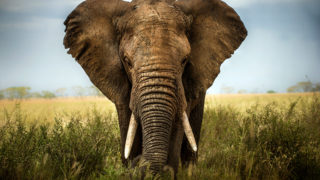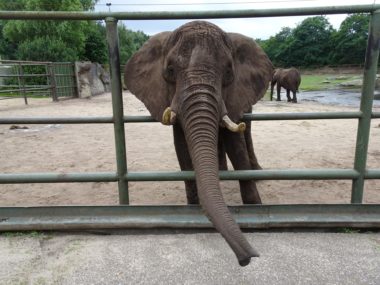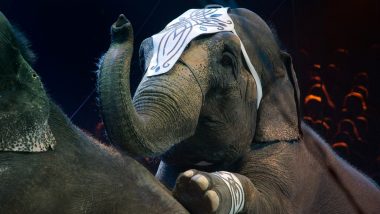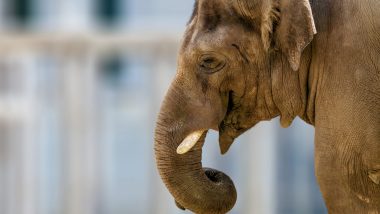
Madras High Court Uses Child Custody Approach to Resolve Dispute Over Legal Ownership of Elephant
By Nicole Pallotta, PhD, Senior Policy Program Manager
Contents
Summary/intro
Summary: In October 2020, the Madras High Court in India resolved an “ownership” dispute involving an elephant named Lalitha using the “best interests” standard used in child custody cases. In assessing her interests, the Court paid special attention to Lalitha’s mental well-being, noting her bond with her caregiver and the psychological trauma that she would experience if she were forcibly relocated. This important ruling illustrates an emerging jurisprudence related to animal custody, which recognizes the interests of the animal in addition to the claims of the human parties in such disputes.
Just solutions to legal issues may sometimes lie outside the formal statutory framework. Judges should therefore boldly think outside the box and not feel inhibited or timid. I say so because in the case on hand that pertains to “Lalitha” a female elephant, I found light not in the provisions of the Wild Life (Protection) Act, 1972 but in the pages of Peter Wohlleben’s “‘The Inner Life of Animals.” – Justice G.R. Swaminathan, Madras High Court
In October 2020, the Madras High Court in India1 resolved a dispute over the legal ownership2 of an elephant named Lalitha using the “best interests” standard commonly used in child custody cases. Taking Lalitha’s physical and psychological well-being into account led Justice G.R. Swaminathan to rule contrary to the applicable administrative law, finding in a 12-page decision: “Just solutions to legal issues may sometimes lie outside the formal statutory framework” (p.2).
This case is notable because, while disputes of this nature are often referred to as custody cases, animals are classified as “property” under the law. Therefore, the central legal issue is generally framed in terms of ownership. With some exceptions, this is how courts have traditionally approached the issue.
However, courts and legislatures have increasingly begun to consider the interests of the animal in such disputes, as opposed to resolving them according to a strict property analysis. Lalitha’s case exemplifies this jurisprudential shift.
Who is Lalitha’s Legal Owner?
At the center of this case was an elephant named Lalitha, who had been sold multiple times after her original owner purchased her in 1988, and whose current legal ownership was in dispute. The case came before the Madras High Court after her current caregiver’s request for an ownership certificate was denied by a lower court.
Lalitha’s current caregiver (“petitioner”) then requested a writ of certiorari for review of the lower court’s decision. Respondents3 requested dismissal of the writ petition, arguing that India’s federal wildlife protection law, enacted in 1972, had prevented them from issuing the ownership certificate.4
The facts of the case were as follows:
The writ petitioner purchased [Lalitha] on 08.05.2000. He then applied in Form 11 on 19.06.2002 seeking transfer of ownership. The said request was kept pending and finally rejected on 23.03.2020. In the
meanwhile, the petitioner was visited with penalties for having
transported Lalitha from one place to another without prior permission.
The petitioner wants this Court to set aside the rejection order and
direct the respondents to grant him certificate of ownership in respect
of Lalitha. (p.3)
Justice Swaminathan upheld the lower court’s decision — rejecting the petitioner’s request for an ownership certificate — finding it “beyond dispute” that the sale of Lalitha by her original owner and all subsequent sales were illegal.
Lalitha’s case could have ended here, but it did not.
Freedom to Express Normal Behaviors
As a matter of law, the case seemed settled. But Justice Swaminathan was troubled by what the conclusion meant for Lalitha herself. While upholding the lower court’s decision, he asked:
But what is the sequitur? According to the respondents, the logical consequence is that the petitioner will have to surrender possession of the animal. . . The question that arises for my consideration is whether this can be permitted. (p.4)
It is here that Justice Swaminathan shifts from the question of legal ownership, which is clear under the applicable federal law, to a consideration of Lalitha’s interests — which he finds determinative to a just resolution of the case. In assessing the best course of action for Lalitha herself, he notes the capabilities of elephants, including their emotional and cognitive capacities:
Elephants are known to be sensitive and possessed of self awareness. They have passed what is known as “mirror test”. The German naturalist Peter Wohlleben, after years of direct, personal observation, says that animals also feel the very same emotions which the humans are capable of. Feelings of love, grief and compassion are equally found in the animals. (p.5)
Next, he discusses the relevant animal protection laws, including case law, that form the basis of his decision to move beyond the proximate legal question of rightful ownership.
 First, Justice Swaminathan cites Article 51A (g) of the Constitution of India, which “calls upon us to have compassion for living creatures.” Second, he cites the Supreme Court of India’s decision in Animal Welfare Board of India Vs. A. Nagaraja and others (2014), which declared that “five internationally recognized freedoms for animals . . . shall be read into Sections 3 and 11 of the Prevention of Cruelty to Animals Act, 1960, and be protected and safeguarded by the Governments” (pp. 5-6).5
First, Justice Swaminathan cites Article 51A (g) of the Constitution of India, which “calls upon us to have compassion for living creatures.” Second, he cites the Supreme Court of India’s decision in Animal Welfare Board of India Vs. A. Nagaraja and others (2014), which declared that “five internationally recognized freedoms for animals . . . shall be read into Sections 3 and 11 of the Prevention of Cruelty to Animals Act, 1960, and be protected and safeguarded by the Governments” (pp. 5-6).5
Drawing on the Supreme Court’s ruling, Justice Swaminathan found: “Lalitha is entitled to express her normal patterns of behavior” (p.6).
Most importantly, he found that relocating Lalitha would cause her emotional trauma, and that therefore the approach used in child custody cases must be followed in her case as well.
A Deep Psychological Wound
In calculating what would be best for Lalitha, Justice Swaminathan assessed both her physical health and psychological well-being. He concluded that removing Lalitha from her current caregiver’s custody would “traumatize” and inflict a “deep psychological wound” on her.
Noting that Lalitha had been with the petitioner for more than 20 years, he wrote:6
She has developed a great bonding with her caretakers. Forcible relocation in alien surroundings is sure to traumatize her. I therefore felt that the approach that we adopt in child custody cases must be followed in the case of Lalitha also. (pp. 6-7)
After personally conducting a surprise inspection at the location where Lalitha was kept, Justice Swaminathan noted with pleasure that she was “not at all chained” and was “sumptuously fed.” He checked for injury marks on her and found none, noting she appeared “happy and healthy” and “exhibited great friendliness” (p. 7).
In addition to assessing her physical appearance and behavior, he placed significant weight on Lalitha’s mental well-being and the potentially negative emotional impacts of relocation.
Lalitha has been accustomed to a certain lifestyle all these years. . . . She is being fed well. She is in good health. In fact, the veterinarians appointed by the department have certified that she is being maintained properly by the petitioner. Removing her from the petitioner’s custody is sure to inflict a deep psychological wound on her. It is certainly not in her best interests. Applying the yardstick of what is good for Lalitha, I have to hold that the present arrangement should continue. (pp. 8-9)
The High Court also received assurances in writing that the land that Lalitha lives on— “a coconut grove spread over one and half acres” — which is owned by a third party, would not be sold or encumbered during her lifetime.7
Animal Dignity
In his ruling, Justice Swaminathan also references Lalitha’s dignity—finding it significant that it remains intact:
I questioned the caretakers regarding Lalitha’s maintenance. I was told that Lalitha is taken to some of the well known temples and Dargas of south Tamil Nadu and the organizers of the religious functions pay for her majestic participation. Lalitha does not beg on the roads. Her dignity is maintained intact. (pp. 7-8)
Although he finds her dignity undamaged, Justice Swaminathan does not stop there. He goes deeper to critically examine the more fundamental question of whether her “participation” in religious ceremonies is exploitative. He takes a view similar to human-animal studies scholars who have begun to consider whether animal labor, rather than being inherently oppressive, can in some situations be ethical, beneficial to animals, and a potential source of social membership and perhaps even enhanced rights.8
 I have written elsewhere specifically about the case of dogs that because some of them do enjoy having a job or task, certain individual dogs in some situations could fill a “worker” role without exploitation as long as their consent and agency — or their capacity to act independently and make free choices — is respected.9 It is unclear whether this type of symbiotic relationship could meaningfully exist between a human and a captive wild animal, like an elephant.
I have written elsewhere specifically about the case of dogs that because some of them do enjoy having a job or task, certain individual dogs in some situations could fill a “worker” role without exploitation as long as their consent and agency — or their capacity to act independently and make free choices — is respected.9 It is unclear whether this type of symbiotic relationship could meaningfully exist between a human and a captive wild animal, like an elephant.
However, Justice Swaminathan views Lalitha’s situation using a similar frame, noting that some animals enjoy working as part of a partnership, if they are treated with kindness and respect for their needs:
In my view, this does not amount to exploitation. Peter Wohlleben in the chapter “In the Service of Humanity”, in his Book remarks that when the log-haulers are kind and give rest to their horses, the animals are eager to work. One can find similar human-animal partnership with shepherds and their dogs which also follow verbal commands. This is another example of animals taking pleasure in their work, as we can clearly see if we watch sheepdogs racing around a flock of sheep to round them up (Page 251). The caretakers told me that Lalitha is carefully transported to such religious places and not made to walk on tar roads. (p. 8)
Leaving aside the question of whether wild animals can meaningfully consent to enter partnerships with humans, viewing Lalitha’s well-being through this lens — and indeed taking her well-being into account at all, which Justice Swaminathan did not have to do — is less anthropocentric than a strict property analysis.
As a human construct, the concept of dignity stands somewhat apart from physical and mental well-being. In addition to being referenced in this decision, animal dignity has also been enshrined in some laws and national constitutions, with some asking whether it represents a path forward for animal protection law.
In assessing the pragmatic utility of dignity, Bernet Kempers (2020)10 finds the concept has potential to advance the development and interpretation of animal protection legislation:
Despite its conceptual vagueness, the concept of ‘animal dignity’ as a normative principle might offer a promising way out of the current stalemate between animal welfare versus animal rights and can lead the central debate in a new direction. (p. 194)
Similar discussions are happening around the practical utility of recognition of animal sentience in legislation and its significance as a foundational concept in animal law.11 Whether symbolic, practical, or both, it is a step forward to see concepts like dignity and sentience being cited in decisions that center animals’ interests.
Determining Bonds Non-Anthropocentrically
While it is undoubtedly critically important to take an animal’s interests into consideration during ownership/custody disputes, care must be taken to avoid anthropocentric interpretations of human-animal bonds. For example, during debates on the proposed ban on using wild animals in circuses in France, the Star Tribune reported the following quote from a lion trainer: “A trainer doesn’t hurt an animal, he seeks complicity, respect between humans and animals…I have 12 magnificent white lions. They love me….It is out of question for me to let my animals go away.”
 Human interpretations of mutual “love” and “respect” in scenarios where captive animals are clearly being exploited for profit are suspect on their face and must be viewed critically by courts. In the case of the lions cited above, it seems clear they would be better off in a sanctuary where they would have the ability to express their natural behaviors.
Human interpretations of mutual “love” and “respect” in scenarios where captive animals are clearly being exploited for profit are suspect on their face and must be viewed critically by courts. In the case of the lions cited above, it seems clear they would be better off in a sanctuary where they would have the ability to express their natural behaviors.
According to the criteria Justice Swaminathan used in determining what is best for Lalitha (including a personal inspection of her living situation), one would assume that in a hypothetical custody battle statements like the lion trainer’s would be heavily scrutinized. In these situations an expert witness — such as an impartial expert in animal behavior — could be used to speak for the animal or to act as her advocate in court.
The Rights of the Animal Are More Relevant
In concluding his ruling, Justice Swaminathan notes the apparent contradiction between his actions: on the one hand upholding the previous order denying an ownership certificate to Lalitha’s current caregiver, and on the other ruling that she may remain with him. He observes: “Of course, I must justify as to how having sustained the impugned order, I could permit the status quo to continue” (p. 9).
It is here that the full force of this ruling can be appreciated, as Justice Swaminathan finds that Lalitha’s rights are paramount. He explicitly states that although the administrative decision (to deny issuance of an ownership certificate) was valid in law, Lalitha’s rights are more relevant, and thus determine the outcome of the case.
He grounds this conclusion in a passage from an administrative law text that was approvingly quoted by the Supreme Court of India in 1994. The gist of the passage is that earlier cases “took the robust line that the law had to be observed, and the decision invalidated whatever the administrative inconvenience caused” but that courts nowadays recognize that “such an approach is not always appropriate and may not be in the wider public interest.”12
Justice Swaminathan flips this conclusion to justify elevating Lalitha’s interests above strict observance of the law:
If there can be cases where after the administrative decision is found to be bad in law, the logical consequences do not follow, the reverse can also equally hold good. In other words, the administrative decision may be found to be valid in law and yet there can be no sequitur. In the case on hand, the rights of the animal are more relevant and they determine the adjudicatory outcome and not the formal validity of the administrative order. (p. 10) [emphasis added]
Conclusion
 This important ruling exemplifies an emerging jurisprudence related to animal custody disputes, which recognizes the interests of the animal in addition to the claims of the human parties. It is more common for such disputes to involve companion animals, but this is not the first time a pioneering ruling has involved an elephant in recent months.
This important ruling exemplifies an emerging jurisprudence related to animal custody disputes, which recognizes the interests of the animal in addition to the claims of the human parties. It is more common for such disputes to involve companion animals, but this is not the first time a pioneering ruling has involved an elephant in recent months.
Last year, a groundbreaking decision by the Islamabad High Court unequivocally recognized that animals have legal rights. At the heart of this case was Kaavan, an elephant who had for decades been chained in a small barren enclosure at a zoo in Pakistan’s capital city, and is now — thanks to the tireless work of animal advocates and Chief Justice Athar Minallah — living in a sanctuary.
For decades, the Animal Legal Defense Fund has submitted amicus briefs in animal custody cases, urging courts to take the interests of the animal into account when adjudicating these disputes. In the U.S., three states (Alaska, Illinois and California) since 2016 have passed legislation specifically providing guidance to courts regarding the interests, well-being, or care of companion animals in divorce proceedings. As we continue our work to ensure that animals have a legal status beyond mere property, we expect these trends to continue.
To reiterate the inspiring words of Justice Swaminathan:
“Just solutions to legal issues may sometimes lie outside the formal statutory framework. Judges should therefore boldly think outside the box and not feel inhibited or timid.”
Further Reading
- Sharma, Devika. Madras HC: While protecting an elephant from psychological wound, HC disallows removal of ‘Lalitha’ from caretaker’s custody. Exhaustive analysis of an elephant’s bonding with caretaker.” The SCC Online Blog. January 5, 2021.
- BEFORE THE MADURAI BENCH OF MADRAS HIGH COURT DATED: 10.09.2020 CORAM THE HONOURABLE MR.JUSTICE G.R.SWAMINATHAN W.P.(MD)No.7655 of 2020 and W.M.P(MD)No.7151 of 2020
References
- The Madras High Court is one of 25 regional high courts in India. Appeals from these courts go to the Supreme Court of India.
- The Animal Legal Defense Fund advocates the use of terms like “guardian” or “caregiver” instead of “owner” but uses the latter when that terminology is legally relevant, such when it is used in a court decision or legislation.
- Respondents included: the principal chief conservator of forests and chief wild life warden; the conservator of forests; the wild life warden; and the district forest officer.
- “As per Section 43 (1) of the [Wild Life (Protection) Act, 1972], no person having in his possession captive animal in respect of which he has a certificate of ownership shall transfer by way of sale or offer for sale or by any other mode of consideration of commercial nature such animal. According to Section 39 (3), no person shall, without the previous permission in writing of the Chief Wild Life Warden or the authorised officer acquire or keep in his possession, custody or control, or transfer to any person, whether by way of gift, sale or otherwise any wild animal falling within the purview of the Act.”
- The Supreme Court of India noted these five freedoms are recognized by the World Organization of Animal Health and include: (1) freedom from hunger, thirst and malnutrition; (2) freedom from fear and distress; (3) freedom from physical and thermal discomfort; (4) freedom from pain, injury and disease; and (5) freedom to express normal patterns of behavior.
- He also noted the state had not intervened to take her away during these 20 years, adding: “It is not as if the writ petitioner was keeping her secretly.” Of course, the length of time a captive animal has been in her current situation is meaningless without context. Here that context includes the other observances by the Court: namely that Lalitha had bonded with her caregiver and that she was well-taken care of with her needs met.
- Justice Swaminathan noted that Lalitha “also gets copious amounts of water to drink and to bathe. The ambience is highly conducive” (p. 9). He further ruled that the respondents (government wildlife authorities) can inspect Lalitha at any time.
- See, for example: Blattner, Charlotte E., Kendra Coulter, and Will Kymlicka. 2019. Animal Labour: A New Frontier of Interspecies Justice? Oxford, England: Oxford University Press.
- Pallotta, Nicole R. “Dogs on Film: Status, Subjectivity, and Representation.” Paper presented at the American Sociological Association Annual Meeting, August 11, 2020.
- Bernet Kempers, Eva. 2020. “Animal Dignity and the Law: Potential, Problems and Possible Implications.” Liverpool Law Review. Vol. 41.
- See for example: Blattner, Charlotte E. 2019. “The Recognition of Animal Sentience by the Law.” Journal of Animal Ethics. Vol. 9, No. 2.
- “Passage from Judicial Remedies in Public Law by Clive Lewis approvingly quoted by the Hon’ble Supreme Court in (1994) 1 SCC 648 (Shri Malaprabha Co-Operative Sugar Factor Vs. Union Of
India and another)” (p. 9).
Related
-
Washington Governor Signs Animal Protection Bills into Law
The four laws will offer better protections for companion animals and keep wild animals from being exploited for entertainment in the stateMay 16, 2025 News -
Animal Advocates Urge USDA to Withhold License from Troubled Puerto Rico Zoo
In a letter to the USDA, the Animal Legal Defense Fund and others explain the zoo has repeatedly violated standards of the Animal Welfare ActJune 2, 2021 Press Release -
Animal Advocates Urge Puerto Rico Officials to Take Action on Troubled Zoo
Animal Legal Defense Fund letter asks Puerto Rico governor to investigate illegal treatment of endangered species and other animals at Dr. Juan A. Rivero National Zoological ParkDecember 16, 2019 Press Release



